Plot
The CVN news network's nightly program, starring Don Tobin (Watson), with reports from correspondents Michael Boyle (Glenn) and Dorian Waldorf (Shaver), discusses a terrorist bombing of the American embassy in Saudi Arabia that killed the American ambassador. The week before, a global banking crisis, caused by several South American countries defaulting on their loans, led to turmoil in Southwest Asia. Before the unrest spread to Saudi Arabia, Soviet-backed militants led a coup in Oman when the Omani economy collapsed. Shortly after, a new report shows the banking crisis may soon begin to ease.
During this time, Waldorf's Pentagon insider boyfriend is providing off-the-record insight into the White House's response to all these events, and suggests that there may be too many critical events going on at once for the President and his advisers to handle effectively.
The following day, it is revealed that a large military operation was launched to keep the peace in Saudi Arabia, with many American soldiers, ships, and planes being sent at King Fahd's request. This move is heavily criticized - in the US and abroad. The United Kingdom, America's closest ally, refuses to take part in the operation as do many other of America's allies. However, the attitude of the American representatives is clear that they can perform the peacekeeping mission alone, citing the success of the British in the past in containing the Soviets' previous provocation in the area.
In response to this move, which the Soviet Union sees as provocative, the Soviet-backed puppet government in Oman imposes a $10,000 toll for every oil tanker passing through the Strait of Hormuz into the Persian Gulf. The Soviet government claims it will remove the toll if the Americans withdraw troops from Saudi Arabia. The captains of the tankers refuse to pay the toll, effectively creating an economic blockade in which no oil can be transported through the Persian Gulf.
A breaking news alert on the fifth day of the Middle East crisis reveals that a short battle took place between American warplanes and unidentified enemy warplanes, presumed to be from Iran or Kuwait, in which an American reconnaissance plane was shot down over the Persian Gulf before two of the five attacking planes were shot down. The attacking aircraft were presumably aiming for an oil refinery in Ras Tanura in retaliation for Saudi Arabia's request for American troops.
Meanwhile, Waldorf brings a story to CVN: her boyfriend had provided her with satellite photos that suggests that Soviet forces have disappeared from their border with the Middle East, possibly as a covert invitation to mutually withdraw from the area — an invitation that could have been ignored in the flood of information the multiple global crises have created ("The signal-to-noise ratio in there [The White House] is horrendous."). However, Tobin reluctantly insists that Waldorf have more than one source for the story.
On day six of the crisis, an American aircraft carrier, the USS Nimitz and its battle group, armed with both nuclear and conventional weapons, are sent by the U.S. President to the Persian Gulf to ensure the free passage of oil tankers in the region; the President also activates Selective Service, drafting thousands of soldiers in anticipation of a larger conflict. The Soviet Union quickly responds to this action by sending submarines to the Persian Gulf. CVN sends Michael Boyle to the Nimitz to cover the deployment. The Soviets publicly criticize the United States for failing to accept their offers of conciliation and mutual withdrawal from the area, implying that Waldorf's information was correct and that the US may have given up an opportunity for a peaceful solution.
On day eight of the crisis, in response to the growing urgency of the situation, CVN begins to broadcast 24 hours a day. In addition, the US begins shutting down its nuclear power plants nationwide, an act noted not to have happened since the Cuban Missile Crisis. Shortly after a State Department briefing, the Defense Secretary dies, perhaps of a heart attack brought on by the stresses of crisis management.
On day nine, the crisis deepens when an Omani gunboat attacks and apparently destroys an unarmed Dutch vessel which tried to go through the Strait of Hormuz. The CVN broadcast also notes the presence of Soviet attack submarines near the site of the attack. At this point, people begin to evacuate cities, overseas air travel is suspended by the FAA and Civil Aeronautics Board, many American schools begin closing, the Strategic Air Command redeploys B-52 bombers throughout the nation's airports, and people are urged to stay off their phones. By nightfall, an evacuation of the White House is ordered. Later, Waldorf is met by her boyfriend at the news studio, offering to take her along in the evacuation—the President has delegated tactical nuclear launch authority to the Nimitz battle group commander after the destruction of the Dutch vessel, and the chances of a nuclear exchange in the Gulf have increased significantly. Waldorf chooses to remain in Washington to continue her work.
A night battle then erupts between Omani gunboats and the U.S. Navy in the Strait of Hormuz, with an Omani gunboat firing on and disabling a warship before being destroyed by the other American vessels. Despite the gravity of the situation, Tobin discusses his optimistic viewpoint of the situation with correspondent Eric Sevareid, believing that "[r]easonable people, once they've looked the Devil in the face, aren't going to shake hands with him."
Shortly after the Omani gunboat exchanges fire with the American ship, a Soviet submarine slips through the perimeter of American picket ships and is tracked on a course towards the Nimitz, which attempts to defend itself by deploying depth charges in an effort to sink the sub. When these fail to stop the submarine, a large explosion erupts from the water, suggesting that a nuclear depth bomb was used to destroy it. Boyle evacuates into the carrier's island, confronting an officer to find out who provided authorization for the nuclear attack, but cannot get a clear answer. Shortly thereafter, a nuclear weapon detonates inside the battle group, causing an unknown level of damage, though the Nimitz remains afloat. Shortly thereafter, Boyle and the Nimitz lose contact with CVN, as high levels of atmospheric radiation interfere with the broadcast.
At this point, the White House is completely evacuated, with the President, Joint Chiefs of Staff, and other White House officials evacuated onto the National Emergency Airborne Command Post plane with the Strategic Air Command's airborne command center Looking Glass in accompaniment, and the Emergency Broadcast System is activated.
In the moments before CVN's broadcast is transferred over to the Emergency Broadcast System, Tobin reiterates his optimism, discussing the opinions of a deceased colleague who was considered an expert in nuclear war scenarios. His colleague held the belief that a nuclear exchange would someday take place, but when the two superpowers were confronted with the horror of the situation, they would choose peace over war. As a now-bewildered Tobin prepares to turn things over to the EBS, it is obvious that he is shaken by the events that have occurred, and is almost mournfully fearful over the inescapable realization that there may very well be no future at all for the Earth or humankind.

The Gulf of Oman or Sea of Oman, also known as Gulf of Makran or Sea of Makran, is a gulf that connects the Arabian Sea with the Strait of Hormuz, which then runs to the Persian Gulf. It borders Iran and Pakistan on the north, Oman on the south, and the United Arab Emirates on the west.

Oman is a country on the southeast coast of the Arabian Peninsula, situated in West Asia, bordering the Arabian Sea, Gulf of Oman, and Persian Gulf, between Yemen and the United Arab Emirates (UAE). The coast of Oman was an important part in the Omani empire and sultanate.

The Persian Gulf, sometimes called the Arabian Gulf, is a mediterranean sea in West Asia. The body of water is an extension of the Indian Ocean located between Iran and the Arabian Peninsula. It is connected to the Gulf of Oman in the east by the Strait of Hormuz. The Shatt al-Arab river delta forms the northwest shoreline.

The Strait of Hormuz is a strait between the Persian Gulf and the Gulf of Oman. It provides the only sea passage from the Persian Gulf to the open ocean and is one of the world's most strategically important choke points. On the north coast lies Iran, and on the south coast lies the Musandam peninsula, shared by the United Arab Emirates and Musandam Governorate, an exclave of Oman. The strait is about 90 nautical miles (167 km) long, with a width varying from about 52 nmi (96 km) to 21 nmi (39 km).

The Nimitz class is a class of ten nuclear-powered aircraft carriers in service with the United States Navy. The lead ship of the class is named after World War II United States Pacific Fleet commander Fleet Admiral Chester W. Nimitz, who was the last living U.S. Navy officer to hold the rank. With an overall length of 1,092 ft (333 m) and a full-load displacement of over 100,000 long tons (100,000 t), the Nimitz-class ships were the largest warships built and in service until USS Gerald R. Ford entered the fleet in 2017.

USS Dwight D. Eisenhower (CVN-69) is a nuclear-powered aircraft carrier currently in service with the United States Navy. Commissioned in 1977, the ship is the second of the ten Nimitz-class aircraft carriers currently in service, and is the first ship named after the 34th President of the United States and General of the Army Dwight D. Eisenhower. The vessel was initially named simply as USS Eisenhower, much like the lead ship of the class, Nimitz, but the name was changed to its present form on 25 May 1970. The carrier, like all others of her class, was constructed at Newport News Shipbuilding Company in Virginia, with the same design as the lead ship, although the ship has been overhauled twice to bring her up to the standards of those constructed more recently.

Carrier Strike Group 9 is a U.S. Navy carrier strike group. Commander Carrier Strike Group 9 is responsible for unit-level training, integrated training, and material readiness for the ships and aviation squadrons assigned to the group. The group reports to Commander, U.S. Third Fleet, which also supervises its pre-deployment training and certification that includes Composite Unit Training Exercises.

In military strategy, a choke point is a geographical feature on land such as a valley, defile or bridge, or maritime passage through a critical waterway such as a strait, which an armed force is forced to pass through in order to reach its objective, sometimes on a substantially narrowed front and therefore greatly decreasing its combat effectiveness by making it harder to bring superior numbers to bear. A choke point can allow a numerically inferior defending force to use the terrain as a force multiplier to thwart or ambush a much larger opponent, as the attacker cannot advance any further without first securing passage through the choke point.
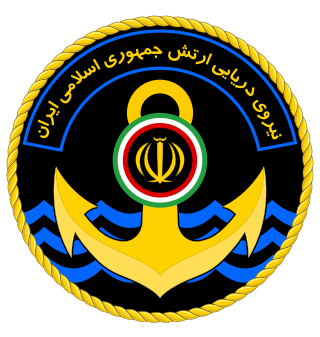
The Islamic Republic of Iran Navy or Iranian Navy, officially abbreviated NEDAJA, is the naval warfare service branch of Iran's regular military, the Islamic Republic of Iran Army (Artesh). It is one of Iran's two maritime military branches, alongside the Navy of the Islamic Revolutionary Guard Corps (IRGC).
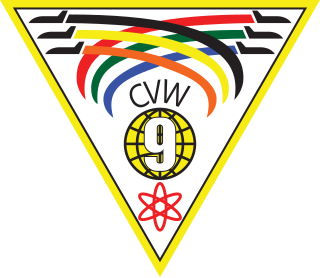
Carrier Air Wing Nine (CVW-9) is a United States Navy aircraft carrier air wing based at Naval Air Station Lemoore. The Air Wing is currently assigned to the aircraft carrier USS Abraham Lincoln (CVN-72). The Tail Code of aircraft assigned to CVW-9 is NG.

Strike Fighter Squadron 146 (VFA-146) also known as the "Blue Diamonds" is a United States Navy operational fleet strike fighter squadron based at Naval Air Station Lemoore California. They fly the F/A-18E Super Hornet and are attached to Carrier Air Wing 17, deployed aboard USS Nimitz. Their tailcode is NA and their radio callsign is Diamond.
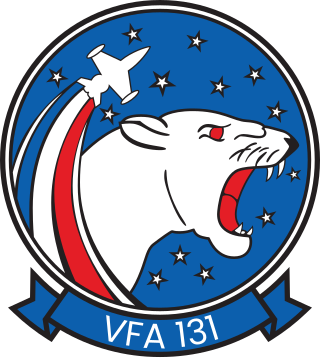
Strike Fighter Squadron 131 (VFA-131), also known as the "Wildcats", is a United States Navy F/A-18E Super Hornet fighter squadron stationed at Naval Air Station Oceana. Their radio call sign is "Wildcat" and their aircraft tail code is AC.

The Jabrids or Banu Jabr were an Arab dynasty that ruled all of Arabia except for Hejaz and Yemen, and expanded into Iran's southern coast, controlling the Strait of Hormuz

The Iraq Medal was instituted by Queen Elizabeth II, Queen of Australia on the advice of the Australian Prime Minister John Howard in 2004. The Iraq Medal is awarded to Australian Defence Force (ADF) personnel who served in or around Iraq during the Iraq War. ADF personnel are also recognised by the 'IRAQ 2003' clasp to the Australian Active Service Medal.
"Filipino Monkey" is a taunt used by radio pranksters in maritime radio transmissions since at least the 1980s, especially in the Persian Gulf. This taunt is also used as a name for pranksters who make odd, confusing, or even threatening calls on VHF marine channel 16, which is the VHF calling and distress channel. Ships at sea are required to monitor the channel, which is meant to be used only to make contact before changing to a working channel.
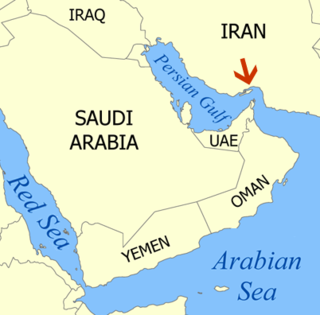
The 2011–12 Strait of Hormuz dispute was a dispute between a coalition of countries and Iran. The dispute arose on 27 December 2011, when Iranian Vice President Mohammad-Reza Rahimi threatened to close the Strait of Hormuz. In late April 2019 Iran said that it will block any shipping if it was barred from using the strategic waterway and in face of US sanctions
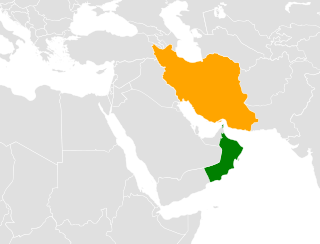
Iran–Oman relations are bilateral relations between Oman and Iran. The two countries currently share diplomatic and economic ties dating back to the Pahlavi period. Oman considers Iran not to be a threat perceived by the other Arab states of the Persian Gulf. Both countries are members of the Organisation of Islamic Cooperation, the Non-Aligned Movement and the Group of 77. Iran has an embassy in Muscat whilst Oman has an embassy in Tehran.

On 12 May 2019, four commercial ships were damaged off Fujairah's coast in the Gulf of Oman. The ships included two Saudi Arabian registered oil tankers, a Norwegian registered oil tanker, and an Emirati registered bunkering ship. The ships were anchored on the United Arab Emirates territorial waters for bunkering in Port of Fujairah. The Ministry of Foreign Affairs of the United Arab Emirates reported that the ships had been subject to a "sabotage attack". The United Arab Emirates launched a joint investigation probe with United States and France. The initial investigation assessment determined that 5-to-10-foot holes near or below all the ships' waterlines were probably caused by explosive charges.

On 13 June 2019, two oil tankers were attacked near the Strait of Hormuz while they transited the Gulf of Oman. The Kokuka Courageous, flagged in Panama and operated by a company based in Japan, and Front Altair, flagged in Marshall Islands and operated by a company based in Norway, were attacked, allegedly with limpet mines or flying objects, sustaining fire damage. American and Iranian military personnel responded and rescued crew members. The attacks took place a month after the similar May 2019 Gulf of Oman incident and on the same day, Iranian Supreme Leader Iran Ali Khamenei met with Japanese Prime Minister Shinzō Abe in Iran. Abe was acting as an intermediary between US President Donald Trump and Khamenei.

The International Maritime Security Construct (IMSC) is a consortium of countries whose official stated aim is the maintenance of order and security in the Persian Gulf, Gulf of Oman, Gulf of Aden and Southern Red Sea, particularly regarding maritime security of global oil supply routes. It was formed on 16 September 2019 in Bahrain, by the United Kingdom, Australia, Albania, Saudi Arabia, Bahrain, Lithuania, the United Arab Emirates, and the United States. The operational arm of the IMSC is Coalition Task Force SENTINEL.


















